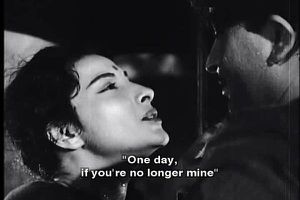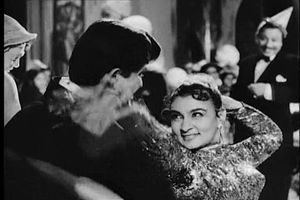Shree 420: Raj Kapoor's masterpiece
Publié le 19 Décembre 2007
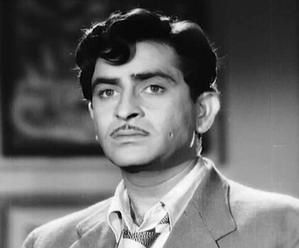
Another classic ! Raj Kapoor (actor and director) and Nargis are once again at the top of their art, and create a masterful, a superb story of love and temptation, of self-deception and redemption. Not only is the story a moving and profound parable on ambition and success, but the way the film is done is inventive, touching, funny, symbolical… It has everything. These black and white movies had the cardinal virtue of presenting moral issues in a contrast that our modern pictures cannot rival. Were B & W directors conscious that they had one foot further in Art? And wouldn’t you say the realism of colours and digital rendition tends to blur the ethical questions? I particularly appreciated Raj Kapoor in this film. He’s absolutely perfect. And very handsome too! Made me think of Errol Flynn and Clark Gable. His tramp character might well be a copy of Chaplin’s (you can actually see Chaplin’s tricks, the automatic hat-lifting, the shoulder shrug, and whole scenes are Chaplin-like) he loses it quickly enough to embody that wistful and moody Raj that we so easily identify with.
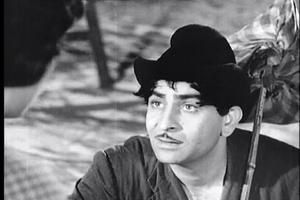
Raj is Everyman, he’s Adam: he is first innocent, full of hope, clever and charming (I loved that little bird-flute of his), he has a determined spirit and a courage which makes him friends with all, and loved by the no-less spirited Vidya. When he falls prey to charmers greater than him, he sways between good and evil, but the good heart is always there, his humanity never relinquishes him. Even in sin he remains potentially redeemable. He does sin, he does taste the acrid apple of corruption and vanity, and even if his innocence dies in that fall (perhaps represented by the false death on the stairs at the end), he will shake off the “mind-forged manacles” that enslave him, destroy the mask of falsehood, and be born again to virtue and love. His saviour is of course Vidya, his love and the voice of his conscience.
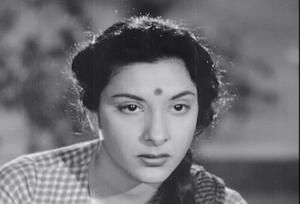
Nargis is a marvel of femininity. Her expressions are a rapture to watch. I remember for instance that moment when she is teaching the children the song Eechak Daana Beechak Daana and her face changes from sweet to severe (and her body from flexible to rigid) as she notices Raj at the window involved in the same guessing as the children, only with a different intention.

She is proud, bursting with life, magnificent, queenly. Oh, that scene in the rain while Raj’s iron is burning a hole in the table at the laundry, and they sing Pyaar Hua Iqraar Hua: it burnt a hole in my heart! She is SO amazing there! There is in her eyes a mixture of rapture, of gravity, of certainty, of tenderness, of subtle and strong presence beyond what words can express. She is youth, she is maturity; she is virginity, and she is motherhood. The beauty of that walk is enhanced by its silent spectators, the watchful tea-merchant, the little children passing by, and the false sets, the false rain only serve to underline the purity of that sheer cinematographic artistry. And oh, the haunting melody of that song, with its nostalgic resonances, combined with its piping joy!

Now, the forces they have in front of them: first of course, Maya, Illusion. Nadira was at the height of her glory too. She’s the eternal temptress here, especially in that arch-famous dance number Mud Mud Ke Na Dekh, where the Audrey Hepburn like diva is surrounded by as stunningly beautiful and fresh faces as hers, all worthy of having the first role in any masala. (Which by and by is a clear sign that beauty on its own is not virtue).
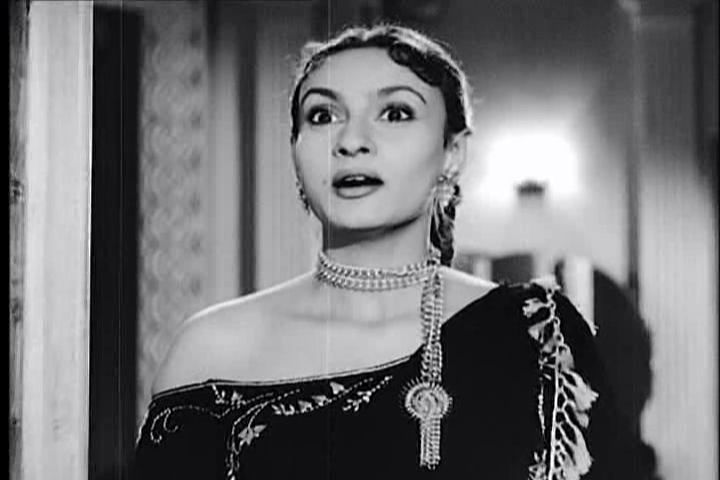
Maya’s sparkling knowing eyes, her full and ravishing figure, the vivacity and the utterly seductive power that, Serpent-like, she displays, are stupendous. No wonder Raj can’t “look back”: there is too much in front of him! That future is far more enticing than the past he’s made to forget, like a spell cast on his soul.
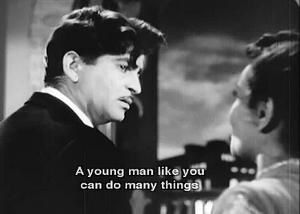
The classic figure of the enchantress is once more portrayed, but in an extremely vivid light. So blinding, in fact, that one can understand Raj, perhaps: the creature in front of him is simply too strong for him. If we didn’t know that Raj is falling into a huge trap, we would be enjoying their show as a high-flying display of pleasure and dream-like romance, and we would sigh with contentedness! But the tiger’s soft fur hides the fiercest claws that Nature has crafted: Maya is Raj’s doom, his Mr Hyde side. She will never love him, but only use him for her own gigantic greed and ego-worship.

More sinister than Maya the Illusionist, there is Seth the Realist (played by actor Nemo). He’s a sight too, a perfect character. I’d say he symbolises the Devil lurking at the back of the scenes, grinning because he’s sure of his ultimate victory. He’s the one who pulls the strings; he’s the one who lays the traps. He doesn’t mind losing temporarily, because he can read in the mind of petty human beings who are manipulated by their desires. Upon seeing his delightful physique, I was reminded of Jabba the Hutt in Star Wars!

Seth doesn’t need to tempt, others do that for him. He’s just there to remind his slaves that they have enslaved themselves from their own free will, and they are now prisoners. Nevertheless the end of the film will show him to be the greater slave of all: he’s enslaved to power and greed, and this slavery will be his downfall.
So this is a very classic (but universal) story, the story of the young ambitious man who believes he can conquer the world (or in this case, Bombay), only to realise too late that it is the world that has conquered him. Innocence and Experience. It contains nevertheless a very urgent question, which revolves around the notions of honesty and poverty. Before realising that he has gambled and lost both honesty and purity, Raj is faced with this dilemma: why should the poor suffer from their poverty, and at the same time justify it by their virtuous resignation? He has noticed (during one of the first episodes of the film, when Raj is picked up by Seth in his car) that the poor are accepted by the rich only if they are reliably virtuous. As soon as they start lying, or double-dealing, they are no longer acceptable as “the poor”: they must be punished and rejected. That’s why Seth, who professes in this scene to want to “help humanity” throws him out: it doesn’t occur to him that lying and faking are a way for Raj (and all poor people) to gain sorely needed advantages which otherwise would always elude them.

So Raj first sees his ascent to riches as a revenge against his humiliation. The poor are made to suffer because of the satisfactions of the rich, and it would be wrong to fight against such an injustice? Can’t the poor transgress a law which is unlawful, since it serves in fact the sole interests of the rich? After all, there is nothing bad in money, it is only a means. One needs it to be happy, to be comfortable, to raise a family, to ensure the safety of the children’s future. Raj feels all this, and if he tricks the rich into letting him benefit from some of that comfort, he sees no wrong in it, and he tries to convince Vidya that his position is honest, and morally acceptable. Such a position is not very far from the anarchist or revolutionary theories which communists have tried to bend into a more organised and socially acceptable programme.
Vidya’s response is interesting (her name, as Carla reminds us, means knowledge - thanks, by the way, Carla, I saw the film thanks to you). It is backed by Raj Kapoor the director too, because the film insists overwhelmingly on the simple but happy life of the street-people. They don’t work, true, they don’t have that source of social recognition. But they dance, sing, share, and they cope. Their resilience is a solution that economists do not generally take into consideration when putting forward arguments with which to counter communism. Vidya tells Raj that his “revenge” has in fact corrupted him, that he has been bought by immoral profiteers who have found another prey to satisfy their greed. She gives him the key to a life of happiness: alone one cannot build a family and ensure a future for the children to come, but together it’s possible. But he hasn’t heard, or if he has, this solution doesn’t weigh against the lure of power and pleasure. Raj hadn’t counted on the fact that he would become infected by the corruption which goes with money, power and artificiality. But Vidya sees that, and resists with all her might to the easy temptation of compromise. All this does not mean, I suppose, that Raj Kapoor was against any type of political reform, but it debunks the moral stance according to which one can feel justified by transgressing the law if one is poor. Certainly the poor have extenuating circumstances if they steal and lie, but not a right to riches, no more than the rich, in fact. The rich have a moral obligation to redistribution, and their social selves are never made any greater thanks to belongings.
There would be a very interesting commentary to be made about what clothes mean as a social and psychological object in the film. As a launderer, Raj deals with visible and arranged surfaces. These surfaces can hide and reveal at the same time. He keeps on telling Vidya that she must not be deceived by appearances, that you can’t tell a book by its cover. But can’t you? In fact, clothes and attire say a great deal. A person’s essence is not summarised by his or her surface, but this surface often tells a story which words don’t always want to admit.
I would like to finish this review by stressing Raj Kapoor’s poetic inventiveness. The poetry and the magic of Śri 420 come first from its moral and spiritual message, but there are scenes where the director’s art is remarkably poetic and inspired. One of them is that moment when a drunken Raj, not understanding what it means to be in danger, leaves Vidya after she has expressed her disapproval of his conduct. This has already happened, by the way, in an early, premonitory scene at the beach:
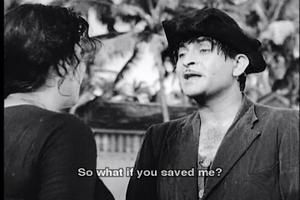
Anyway, here, as Vidya stands rigidly still, looking at him run away from her, the director visualises for us the torment she’s in, and we see another ghost-like, tormented Vidya, extracting itself from her figure, and imploring the moral Vidya to run after him and compromise.
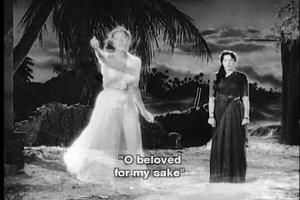
But Vidya doesn’t move, at least outwardly, and as the music rises, the tension between her two passions rages. On one side, love and weak forgiveness, on the other resolve and educational truth. This scene stuns by its sheer inventiveness, even though it has been filmed with the limited means of 1955.
There is another moving scene, again happening at the moment of a song (notice how, in this classic, most of the songs are situated at pivotal moments of the movie, contrary to so many modern Bollywood films where the musical moments are just decorative intervals). Raj is at present at a loss about what his life means, and is back on the street where his friends the beggars and peddlers are seen to sing and enjoy themselves. A young lass is dancing and singing a trite romance: “I’ve given my heart to you”. Raj comes closer, and, transfixed, listens.
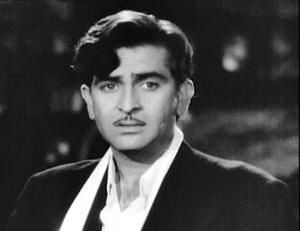
Slowly he understands the words apply to him and Vidya, that his pact with Seth, his association with Maya are traps and deceptions. And the simple song sung by an ordinary street dancer restores in him the truth and the promise he has made to his beloved. He takes up the words and joins in. The music lingers on, the words float in the air, a rickshaw driver catches its tune, and it passes on to a cyclist whom we follow in another part of town, and from there we arrive in sight of Vidya’s porch, where she is sitting, disconsolate, and the miracle of music happens: she too is now singing the same words: “mere dil tujko diya”! What was at first nothing but rhymester’s banal lyrics become an all-important human reality: if they are both in love with one another, nothing should sunder them, purity is again possible, in spite of all separations and distances. In Sri 420, the victory of truth and honesty is not just there to satisfy the spectator’s need for a happy end; it is a testimony to the fact that life is stronger than death, God more powerful than the Devil, and His image set deep inside us, more human than is our animality.
One last moment of great inventiveness, reminiscent of Oscar Wilde's The Portrait of Dorian Gray: Raj passes in front of a mirror, and surveys his new persona, his elegant demeanour. But suddenly, in front of him in the mirror, stands not Raj the gambler, not Raj the Superhero, but Raj the tramp, and he's grinning, he's laughing! A little conversation ensues, where Raj from the happy past inquires whether Raj of the present is happy with all his succese. The new Raj can only admit that no, he isn't, and when his double disappears, this is what happens:
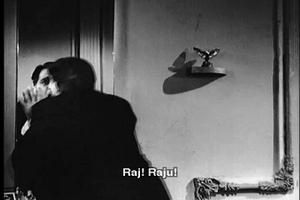
So poignant.
Well, this will be probably be my last instalment before Christmas, so I'll take advantage of it and wish you all a Merry Christmas, and a happy New Year.
One last thing: after the movie review here, a very interesting debate has taken place on Bollywhat about the question of Raj's honesty: you can find it here!
/image%2F1489169%2F20200220%2Fob_9722d6_banner-11.JPG)
